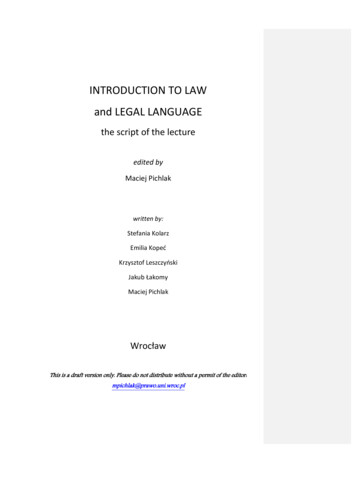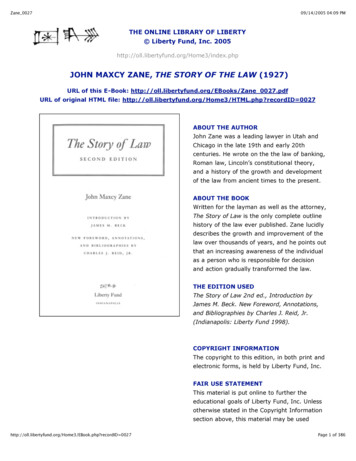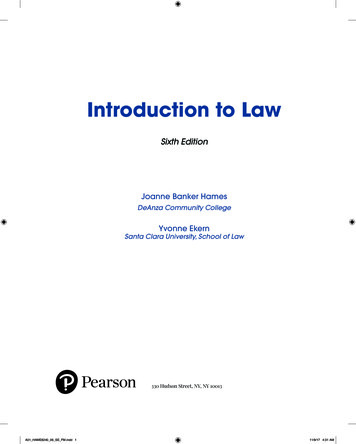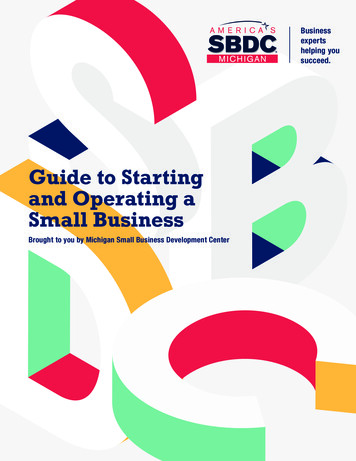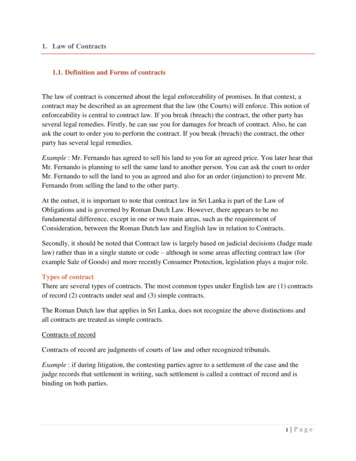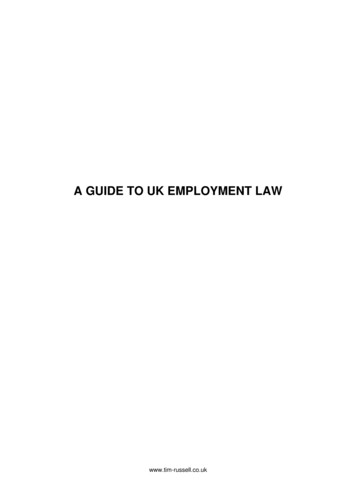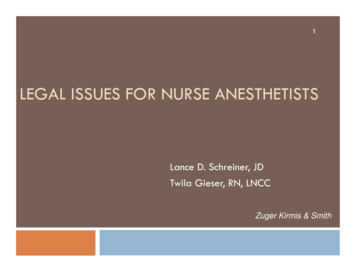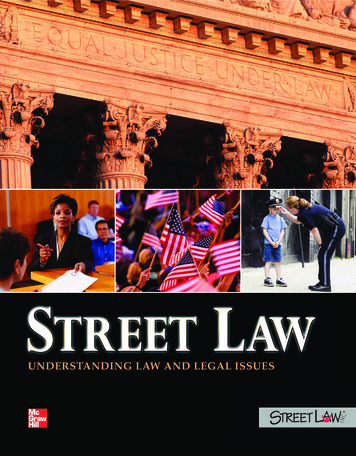
Transcription
UNDERSTANDING LAW AND LEGAL ISSUES
UNDERSTANDING LAW AND LEGAL ISSUESBothell, WA Chicago, IL Columbus, OH New York, NY
Cover images: Royalty-Free/Corbis (top), Guy Cali/Corbis (left), McGraw-Hill Companies, Inc./Jill Braaten, photographer (center), Huntstock / age fotostock (right)mheducation.comCopyright 2011 by The McGraw-Hill Companies, Inc.All rights reserved. No part of this publication may bereproduced or distributed in any form or by any means,or stored in a database or retrieval system, without theprior written consent of The McGraw-Hill Companies, Inc.,including, but not limited to, network storage ortransmission, or broadcast for distance learning.Send all inquiries to:McGraw-Hill Education8787 Orion PlaceColumbus, OH 43240Printed in the United States of America.1 2 3 4 5 6 7 8 9 XXX 15 14 13 12 11 10
STREET LAW: Understanding Law and Legal IssuesPrefaceStreet Law: Understanding Law and Legal Issues is an informative law-based text about people, government, law and community in America. Street Law students will develop a practical understanding ofthe U.S. legal system and prepare for active community participation in our diverse21st century democracy by learning essential legal principles for daily living.Street Law is a student text that also serves as a community guide to civic involvement by providingpractical information about areas of the law that affect the daily lives of all Americans and U.S. residents. Particularly relevant are the areas of consumer, housing, family, and employment law, alongwith marriage, and parental rights. As students’ transition from living with their parents to living ontheir own or even starting their own families, basic awareness of Street Law subjects will becomeimportant in their lives to promote healthy inquiry about public policy and the law.Additionally, Street Law introduces students to fundamental criminal law and constitutional lawprinciples and provides a platform for guided discussion of important public policy issues concerning crime, discrimination, health care, and immigration. These discussions help build intergroupunderstanding, tolerance, leadership and a commitment to social justice by exposing students to awide range of viewpoints and experiences.A Street Law course uses case studies, simulated legal exercises, small group exercises and analytical thought problems to develop higher level thinking skills that prepare students for rigorous college course work in other areas.The Street Law program of the 21st century envisions a new, more active and activist form of civiclearning for everyone. In recent times, political scientists and social commentators have periodicallycautioned that the U.S. has become a “nation of spectators,” a nation of people disengaged from theirgovernments, communities and each other. Consequently, Street Law provides a fresh, new, andcomprehensive framework for students to become more active participants in our dynamic democratic society. All generations of college students and their families will benefit from the wealth ofsubjects covered in the Street Law course. Street Law not only invites students to study law and legalissues that affect them in their daily lives but also challenges students to identify and propose solutions for every day problems that they, their families or communities may face.A Street Law course promotes student knowledge of the law, community participation and individual advocacy in the community using three primary strategies:(1) Developing important core knowledge of practical law principles concerning real issues thatmay affect students, their families and communities in everyday life. This awareness increaseseach student’s capacity to identify problem areas in government and the community thatcould benefit from the student’s knowledge and personal contributions.(2) Increasing student ability to think critically, problem solve, effectively communicate usingoral and written advocacy exercises; and demonstrate familiarity with dispute resolution strategies. This empowering approach develops student confidence and decision making skillsrequired for future leadership positions in government and the community.
(3) Encouraging direct student involvement in the local community by integrating communityactivities and classroom instruction to foster active experiential learning. An emphasis onindividual advocacy is supplemented by visiting speakers and subject matter experts whoshare their expertise on a range of social issues. This approach blends legal theory with theevery day application of law to help students develop positive perspectives toward publicservice and public policy as well as create a local voice to address community concerns.Street Law, Inc. is a nonprofit organization that grew out of a public legal education program at GeorgetownLaw School. Since 1975, Street Law has been providing educational materials about practical law,democracy, and human rights for students of all ages across the United States and around the world.In addition to the student text, there is a comprehensive instructor’s manual and a robust websitewith supplementary resources, vocabulary support, political cartoons, data analysis activities, andan electronic bank of test questions. McGraw Hill also publishes Street Law’s Classroom Guide toMock Trials and Moot Courts. For additional information about the Street Law organization, visitwww.streetlaw.org.Advice to Readers: Law varies from stateto state and is constantly changing. Therefore,someone confronted with a legal problemshould not use this text as a substitute forlegal advice from an attorney.
STREET LAW: Understanding Law and Legal IssuesGuided TourStreet Law: Understanding Law and Legal Issues is an experiential course focused on developing instudents the knowledge and skills necessary to live in our law-saturated society. This course will: provide a practical understanding of lawand the legal system that will be usefulto students in their everyday lives. improve understanding of the fundamental principles and values underlying the U.S. Constitution, laws andlegal system. develop a willingness and an ability toresolve disputes through informal and,where necessary, formal mechanisms. engage students in a practical understanding of the law and legal systemwith interactive methods that focus onthe legal issues relevant to student’slives. involve students with current topics inconsumer law such as cyber crime,identity theft, intellectual propertyrights, terrorism, immigration andmuch more. develop analytical skills as studentsconsider the legal aspects of social,economic, moral and political issuesthrough activities such as mock trialsand moot courts. explore issues with case studies, handson investigative research, and discussions on current legal issues.UNDERSTANDING LAW AND LEGAL ISSUES
Going beyond abstract theory, Street Law:Understanding Lawand Legal Issues meets students “on the street” and addressesthe legal and civic issues that impact their everyday lives.Chapter ProblemsEach chapter includes problem sets aftereach section that are designed to increasestudent comprehension. Many of the questions require higher-order critical thinkingskills as student analyze and explore how lawand the legal system affect their daily livesand shape their judgement of the situationspresented. Responses for all the questionsare available in the Online Teachers Manual.Caption QuestionsPhotos and graphics are found dispersedthroughout the text. Each is connected tothe content and made relevant to the topic ofstudy through discussion and review questions in the captions. These questionsprovide additional opportunities for studentsto demonstrate their comprehension of thecontent being discussed.A democratic system of government cannot function effectively unlessits laws are respected by the people the laws are intended to govern. Inother words, society must be based on the “rule of law.” The rule of lawrequires that the rules by which we are governed be known in advanceand created through democratic processes. Rules should not be made upafter the fact by arbitrary actions or decrees. All members of society—average citizens and government officials such as senators, judges, andeven the president—are required to support the legal system and obey itslaws. No one is above the law.Problem 1.1List 10 of your daily activities (for example, waking up, eating, and going towork). Next to each item, list any laws that affect that activity. What is thepurpose of each law that you identified? Would you change any of these laws?Why or why not?Law and ValuesLaws generally reflect and promote asociety’s values. Our legal system isinfluenced by our society’s traditionalideas of right and wrong. For example,laws against murder reflect the moralbelief that killing another person iswrong. However, not everything that isimmoral is also illegal. For example,lying to a friend may be immoral but isusually not illegal.We expect our legal system to achievemany goals. These include: protecting basic human rights,promoting fairness,helping resolve conflicts,promoting order and stability,promoting desirable social andeconomic behavior, representing the will of the majority, and protectingminorities.therightsofMany of society’s most difficult problems involve conflicts amongthese goals. For example, some laws give preference to minorities. Criticsof these laws argue that they promote reverse discrimination and racialconflict. Proponents of such laws, however, argue that they make up forpast discrimination and promote fairness by leveling an uneven playingfield in society today.This sign reflects society’svalues about right and wrong.What values are placed in conflict bylaws protecting the environment?CHAPTER1 What Is Law?5
The Case of.Relevant cases to Street Law from throughout history are introduced in this feature in each chapter.The case studies include a brief synopsis of therelevant tenets of the case, as well as engaging andthought provoking problems for students to workthrough.The ShipwreckedSailorsThree sailors on an oceangoing freighter werecast adrift in a life raft after their ship sank duringa storm in the Atlantic Ocean. The ship wentddd l h hidHowever, DudBrooks wouldas well get it okilled and ateFive days latcued by a passexplained to auBrooks. After reHuman Rights USAMany countries have more serious humanrights violations than the United States.This point may be one reason some people inthe United States tend to use the term humanrights only when referring to violations thatoccur in other countries. However, humanrights do apply to all people in all countriesaround the world, including the United States.Each unit of Street Law contains a featurecalled “Human Rights USA.” This featureprovides opportunities to look at an aspectof human rights in the United States and willusually include some reference to the UniversalDeclaration of Human Rights (UDHR) foundin Appendix B.Each unit of Street Law contains this feature, whichprovides opportunities to look at a different aspectsof human rights in the United States and oftenrefers students to the Universal Declaration ofHuman Rights (UDHR).Muslim women in hijabs6. A woman is ill and is turned awayfhi lbh dYou Be The JudgeThis feature places the students on the judges’bench and asks them to review cases and makedecisions based on ethical, moral, and legalgrounds. Not only do students have to make toughdecisions, but they also must support their decisions as well. These scenarios expose students tolegal situations across all areas of the law.Independent CourtsAkey element of a democracy is that courtsmust act impartially and make fair decisions without undue influence by outside forces.One method of trying to ensure an independentjudiciary is to appoint judges for a life term. This isdone in the federal system and in a few states.Federal judges are nominated by the president andconfirmed by the Senate. Judges who are appointedfor a life term can make decisions in cases withoutbeing concerned about how it might affect theirreelection.of qualified candidates to the governor, who thenchooses judges from that list.In addition to issues of judicial selection andretention, independent courts must have fairprocedures, the power of judicial review, and thebenefit of an executive branch that will enforcecourt orders if necessary.In some countries, judges and courts are notindependent. They are influenced or in some casescontrolled by the legislature or the president.Read each of the following situations careful
Law and Democracy inActionLaw and Democracy in Action puts students rightin the heart of the legal realm. Each unit offersthese role-playing and discussion situations thatrequire student involvement in drafting legislation, researching relevant topics, or debating thepros and cons of an issue.Changing the Law: Research and RoWork with your classmates in small groups toresearch one of the proposed laws listedbelow. Then answer the questions that follow. Eachgroup will share its findings. The proposed lawswould: require motorcycle riders of all ages to wearinformation, such as a fsure that all employeesProblem 3.1a. What arguments could be prFor Your InformationSteps in a Typical Mediation SessionStep 1. IntroductionThe mediator helps the people involved inthe dispute feel at ease and explains theground rules for behavior during the mediation. Such rules can include agreeing to remainseated and agreeing that any party mayrequest a break during the mediation.Step 2. Telling the StoryEach person tells what happened. The person who brings up the problem usually tells hisor her side of the story first. No interruptionsare allowed. Then the other person explains hisStep 4. Identifying AlternativThe disputants think of possito the problem. The mediator mand then asks each disputant toor her feelings about each possiSometimes in a difficult situatiomediator might also meet with edisputant separately to discuss hconcerns.Step 5. Revising and DiscussBased on the feelings of the dinvolved, the mediator may helpThese informational inserts provide backgroundfor helping student navigate through real life legalprocesses. From identifying the steps necessary tosuccessful mediation to exposing telemarketingscams, each feature presents students with information to help them overcome basic legalobstacles.Steps to TakeThe Street Law project promotes activism in itsstudents, and this feature presents step-by-stepinstructions to engage students in becoming morecivically active citizens. Students learn the properprocesses for launching complaints, protectingthemselves and their property, and for speaking outfor the less fortunate.Guidelines for ABefore you begin to advocate, think through these step1. Identify the issue. Think about your campus or community. Is there a problem thatneeds to be addressed? How do you know itis a problem? Is it causing harm or preventinggood? Can a new policy or rule address thisissue?2. Set a goal. Visualize a better tomorrow by testify at a p lobby in per attend a com6. Plan for succfirst, second, etfor what? Howsuccessful?
ted here, of a federal, a state, and a localThe Law Where You LiveThis margin feature identifies independent researchtopics and activities that students can do to becomemore legally and civically aware of the environmentin which they live. Activities include internetresearch, conducting phone interviews, or legal factchecking.n Street between 4:00 P.M. and 6:00 P.M.6 and 16 must attend school.ses of taking by force or violence the propbank shall be fined not more than 50,000years or both.ublic streets, the seller must first apply forpersons may discriminate on the basis ofonal origin.ate airline carriers are subject to searcharture area.Research to learnwhere on the Internetyou can find a list andexplanation of yourstate’s statutes.king bodies try to respond to the needsLaw Around the WorldThe Screening LawElecting public officials is an essential part of ademocratic system of government. Manycountries that are relatively new democracies—especially those that used to be dictatorships—haveencountered problems with the election process.For example, they have faced the issue of whetheror not to allow former members of the dictator’spolitical party to run for office or otherwise servein the new government. A senior police official was generallyknown to be fair to citizens but hadenforced the dictator’s laws banningdemonstrations. This person was alsoactive in the revolution that overthrewthe dictatorship.A theater director, jailed for antigovernment actions and regularly tortured inprison, agreed to spy on others as aAs the global community continues to impact ourdaily lives, it is important for students to learn toview law from other perspectives. Understandingof international law, knowledge of foreign views onpunishing crimes, and awareness of differing arguments for or against social and political actions arecrucial skills necessary for teaching tolerance andinstilling a commitment towards social justice.
Supplemental Resources and ProgramsTeachers ManualThis online resource includes chapter summaries, community-based special projects, responses tothe feature activities, ideas for approaching and teaching topics, and a handbook of teaching methods. Each chapter includes detailed materials such as learning outcomes, additional backgroundinformation, discussion topics, student activities, answers to each numbered problem in the text, andanswers to caption questions for photos and graphics.Online Learning Center through McGraw-Hill’s ConnectPlatformThe Online Learning Center enables teachers and students to use Street Law: Understanding Law andLegal Issues well into the the twenty-first century. The site includes chapter overviews and studentself-assessment quizzes. It also includes numerous links for conducting research into cases andissues—both those that are presented in the text as well as emerging and relevant topics. The sitealso contains the course Test Bank and additional teacher resources.CONNECT is an innovative Web-based program designed to help students succeed in their coursework and workplace. You can access supplementary resources for Street Law: Understanding Law andLegal Issues at mcgrawhillconnect.com.Classroom Guide to Mock Trials and Moot CourtsThis guide, an overview of mock trials and moot courts, was developed to incorporate them intoclassroom settings. The workbook contains both lesson plans and actual materials. There are ninemock trial and six moot court simulations.
Preface . . . . . . . . . . . . . . . . . . . . . . . . . . . . . . . . . . . . . . . . . . . . . . . . iiiAbout Street Law, Inc. . . . . . . . . . . . . . . . . . . . . . . . . . . . . . . xxviiiChapter 1 What Is Law? . . . . . . . . . . . . . . . . . . . . . . . . . . . . .4Law and Values . . . . . . . . . . . . . . . . . . . . . . . . . . . . . . . . . . . . . . . . 5Human Rights . . . . . . . . . . . . . . . . . . . . . . . . . . . . . . . . . . . . . . . . . 8Balancing Rights With Responsibilities . . . . . . . . . . . . . . . . . . . . . 12Kinds of Laws . . . . . . . . . . . . . . . . . . . . . . . . . . . . . . . . . . . . . . . . 13Our Constitutional Framework . . . . . . . . . . . . . . . . . . . . . . . . . . . 15Chapter 2 Lawmaking . . . . . . . . . . . . . . . . . . . . . . . . . . . . . .Legislatures . . . . . . . . . . . . . . . . . . . . . . . . . . . . . . . . . . . . . . . . . .Agencies . . . . . . . . . . . . . . . . . . . . . . . . . . . . . . . . . . . . . . . . . . . . .Courts . . . . . . . . . . . . . . . . . . . . . . . . . . . . . . . . . . . . . . . . . . . . . .International Lawmaking . . . . . . . . . . . . . . . . . . . . . . . . . . . . . . . .Chapter 3 Advocacy.The Art of Advocacy . . . . . . . . . . . . . . . . . . . . . . . . . . . . . . . . . . .Lobbying . . . . . . . . . . . . . . . . . . . . . . . . . . . . . . . . . . . . . . . . . . . .Voting . . . . . . . . . . . . . . . . . . . . . . . . . . . . . . . . . . . . . . . . . . . . . . .Campaign Finance Reform . . . . . . . . . . . . . . . . . . . . . . . . . . . . . .19192426262929313438Chapter 4 Settling Disputes. . . . . . . . . . . . . . . . . . . . . . . . 40Methods for Solving Disputes . . . . . . . . . . . . . . . . . . . . . . . . . . . . 41Chapter 5 The Court System.Trial Courts . . . . . . . . . . . . . . . . . . . . . . . . . . . . . . . . . . . . . . . . . .Appeals Courts . . . . . . . . . . . . . . . . . . . . . . . . . . . . . . . . . . . . . . .State and Federal Court Systems . . . . . . . . . . . . . . . . . . . . . . . . . .xiiCONTENTS46465152
Tribal Courts . . . . . . . . . . . . . . . . . . . . . . . . . . . . . . . . . . . . . . . . . 57The Supreme Court of the United States . . . . . . . . . . . . . . . . . . . 58International Courts . . . . . . . . . . . . . . . . . . . . . . . . . . . . . . . . . . . 62Chapter 6 Lawyers.When Do You Need a Lawyer? . . . . . . . . . . . . . . . . . . . . . . . . . . .How Do You Find a Lawyer? . . . . . . . . . . . . . . . . . . . . . . . . . . . .Working with Your Lawyer . . . . . . . . . . . . . . . . . . . . . . . . . . . . . .63646569Chapter 7 Crime in America . . . . . . . . . . . . . . . . . . . . . . . .7474808285889597The Nature of Crimes . . . . . . . . . . . . . . . . . . . . . . . . . . . . . . . . . .Crime on Campus . . . . . . . . . . . . . . . . . . . . . . . . . . . . . . . . . . . . .Gangs and Crime . . . . . . . . . . . . . . . . . . . . . . . . . . . . . . . . . . . . . .Guns and the Law . . . . . . . . . . . . . . . . . . . . . . . . . . . . . . . . . . . . .Substance Abuse and Crime . . . . . . . . . . . . . . . . . . . . . . . . . . . . .Victims of Crime . . . . . . . . . . . . . . . . . . . . . . . . . . . . . . . . . . . . . .Preventing and Reporting Crime . . . . . . . . . . . . . . . . . . . . . . . . . .Chapter 8 Introduction to Criminal Law . . . . . . . . . . .General Considerations . . . . . . . . . . . . . . . . . . . . . . . . . . . . . . . .State and Federal Crimes . . . . . . . . . . . . . . . . . . . . . . . . . . . . . . .Classes of Crimes . . . . . . . . . . . . . . . . . . . . . . . . . . . . . . . . . . . . .Parties to Crimes . . . . . . . . . . . . . . . . . . . . . . . . . . . . . . . . . . . . .Crimes of Omission . . . . . . . . . . . . . . . . . . . . . . . . . . . . . . . . . . .Preliminary Crimes . . . . . . . . . . . . . . . . . . . . . . . . . . . . . . . . . . .Chapter 9 Crimes Against the Person . . . . . . . . . . . . . .Homicide . . . . . . . . . . . . . . . . . . . . . . . . . . . . . . . . . . . . . . . . . . .Suicide . . . . . . . . . . . . . . . . . . . . . . . . . . . . . . . . . . . . . . . . . . . . .Kidnapping . . . . . . . . . . . . . . . . . . . . . . . . . . . . . . . . . . . . . . . . .Assault and Battery . . . . . . . . . . . . . . . . . . . . . . . . . . . . . . . . . . .Rapep ii
Chapter 10 Crimes Against r 11 Defenses126126127.Arson . . . . . . . . . . . . . . . . . . . . . . . . . . . . . . . . . . . . . . . . . . . . . .Vandalism . . . . . . . . . . . . . . . . . . . . . . . . . . . . . . . . . . . . . . . . . .Larceny . . . . . . . . . . . . . . . . . . . . . . . . . . . . . . . . . . . . . . . . . . . .Embezzlement . . . . . . . . . . . . . . . . . . . . . . . . . . . . . . . . . . . . . . .Robbery . . . . . . . . . . . . . . . . . . . . . . . . . . . . . . . . . . . . . . . . . . . .Extortion . . . . . . . . . . . . . . . . . . . . . . . . . . . . . . . . . . . . . . . . . . .Burglary . . . . . . . . . . . . . . . . . . . . . . . . . . . . . . . . . . . . . . . . . . . .Forgery . . . . . . . . . . . . . . . . . . . . . . . . . . . . . . . . . . . . . . . . . . . . .Receiving Stolen Property . . . . . . . . . . . . . . . . . . . . . . . . . . . . . .Unauthorized Use of a Vehicle . . . . . . . . . . . . . . . . . . . . . . . . . .Cybercrime . . . . . . . . . . . . . . . . . . . . . . . . . . . . . . . . . . . . . . . . . .No Crime Has Been Committed . . . . . . . . . . . . . . . . . . . . . . . . .Defendant Did Not Commit the Crime . . . . . . . . . . . . . . . . . . .Defendant Committed the Act, but itWas Excusable or Justifiable . . . . . . . . . . . . . . . . . . . . . . . . . .Defendant Committed the Act, but IsNot Criminally Responsible . . . . . . . . . . . . . . . . . . . . . . . . . .127128Chapter 12 Criminal Justice Process:The Investigation . . . . . . . . . . . . . . . . . . . . . 133Arrest . . . . . . . . . . . . . . . . . . . . . . . . . . . . . . . . . . . . . . . . . . . . . . 134Search and Seizure . . . . . . . . . . . . . . . . . . . . . . . . . . . . . . . . . . . 140Interrogations and Confessions . . . . . . . . . . . . . . . . . . . . . . . . . . 152xivCONTENTS
Chapter 13 Criminal Justice Process:Proceedings Before Trial . . . . . . . . . . . . . .Booking and Initial Appearance . . . . . . . . . . . . . . . . . . . . . . . . .Bail and Pretrial Release . . . . . . . . . . . . . . . . . . . . . . . . . . . . . . .Information . . . . . . . . . . . . . . . . . . . . . . . . . . . . . . . . . . . . . . . . .Preliminary Hearing . . . . . . . . . . . . . . . . . . . . . . . . . . . . . . . . . . .Grand Jury . . . . . . . . . . . . . . . . . . . . . . . . . . . . . . . . . . . . . . . . . .Felony Arraignment and Pleas . . . . . . . . . . . . . . . . . . . . . . . . . . .Pretrial Motions . . . . . . . . . . . . . . . . . . . . . . . . . . . . . . . . . . . . . .Plea Bargaining . . . . . . . . . . . . . . . . . . . . . . . . . . . . . . . . . . . . . .Chapter 14 Criminal Justice Process: The Trial.Right to Trial by Jury . . . . . . . . . . . . . . . . . . . . . . . . . . . . . . . . . .Right to a Speedy and Public Trial . . . . . . . . . . . . . . . . . . . . . . .Right to Compulsory Process and to Confront Witnesses . . . . .Freedom From Self-Incrimination . . . . . . . . . . . . . . . . . . . . . . . .Right to an Attorney . . . . . . . . . . . . . . . . . . . . . . . . . . . . . . . . . .Criminal Appeals . . . . . . . . . . . . . . . . . . . . . . . . . . . . . . . . . . . . hapter 15 Criminal Justice Process:Sentencing and Corrections . . . . . . . . . . .Sentencing Options . . . . . . . . . . . . . . . . . . . . . . . . . . . . . . . . . . .Purposes of Punishment . . . . . . . . . . . . . . . . . . . . . . . . . . . . . . .Parole . . . . . . . . . . . . . . . . . . . . . . . . . . . . . . . . . . . . . . . . . . . . . .Capital Punishment . . . . . . . . . . . . . . . . . . . . . . . . . . . . . . . . . . .Corrections . . . . . . . . . . . . . . . . . . . . . . . . . . . . . . . . . . . . . . . . .173174176177178183CONTENTSxv
Chapter 16 Juvenile Justice . . . . . . . . . . . . . . . . . . . . . . . .187History and Overview of Juvenile Courts . . . . . . . . . . . . . . . . . . 187Status Offenses . . . . . . . . . . . . . . . . . . . . . . . . . . . . . . . . . . . . . . 190Juvenile Justice Today . . . . . . . . . . . . . . . . . . . . . . . . . . . . . . . . . 193Chapter 17 Law and Terrorism . . . . . . . . . . . . . . . . . . . .204The Law in Times of War . . . . . . . . . . . . . . . . . . . . . . . . . . . . . . 205Surveillance and Searches . . . . . . . . . . . . . . . . . . . . . . . . . . . . . . 206Detention, Interrogations, and Torture . . . . . . . . . . . . . . . . . . . . 208Chapter 18 Torts: A Civil Wrong214215218219221225Chapter 19 Intentional Torts232233234240250Chapter 20 Negligence253254254258259260Chapter 21 Strict Liability264265266267269.The Idea of Liability . . . . . . . . . . . . . . . . . . . . . . . . . . . . . . . . . .The Idea of Torts: Yesterday, Today, and Tomorrow . . . . . . . . . .Types of Torts . . . . . . . . . . . . . . . . . . . . . . . . . . . . . . . . . . . . . . .Taking Your Case to Court . . . . . . . . . . . . . . . . . . . . . . . . . . . . .Insurance . . . . . . . . . . . . . . . . . . . . . . . . . . . . . . . . . . . . . . . . . . .Types of Damages . . . . . . . . . . . . . . . . . . . . . . . . . . . . . . . . . . . .Torts That Injure Persons . . . . . . . . . . . . . . . . . . . . . . . . . . . . . .Torts That Harm Property . . . . . . . . . . . . . . . . . . . . . . . . . . . . . .Defenses to Intentional Torts . . . . . . . . . . . . . . . . . . . . . . . . . . .Elements of Negligence . . . . . . . . . . . . . . . . . . . . . . . . . . . . . . . .Duty and Breach . . . . . . . . . . . . . . . . . . . . . . . . . . . . . . . . . . . . .Causation . . . . . . . . . . . . . . . . . . . . . . . . . . . . . . . . . . . . . . . . . . .Damages . . . . . . . . . . . . . . . . . . . . . . . . . . . . . . . . . . . . . . . . . . .Defenses to Negligence Suits . . . . . . . . . . . . . . . . . . . . . . . . . . .Dangerous Activities . . . . . . . . . . . . . . . . . . . . . . . . . . . . . . . . . .Animals . . . . . . . . . . . . . . . . . . . . . . . . . . . . . . . . . . . . . . . . . . . .Defective Products . . . . . . . . . . . . . . . . . . . . . . . . . . . . . . . . . . . .Defenses to Strict Liability . . . . . . . . . . . . . . . . . . . . . . . . . . . . .Chapter 22 Torts and Public Policy. . . . . . . . . . . . . . . . 270Tort Reform . . . . . . . . . . . . . . . . . . . . . . . . . . . . . . . . . . . . . . . . . 271xviCONTENTS
Chapter 23 Contracts276276278279279281Chapter 24 Warranties283284286288Chapter 25 Credit and Other Financial Services289290294299300304305306.
STREET LAW: Understanding Law and Legal Issues Street Law: Understanding Law and Legal Issues is an informative law-based text about people, govern-ment, law and community in America. Street Law students will develop a practical understanding of the U.S. legal system and
